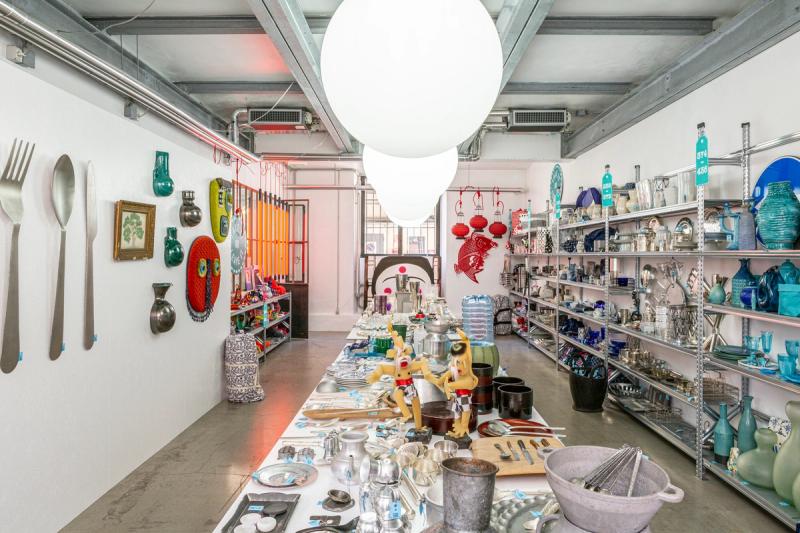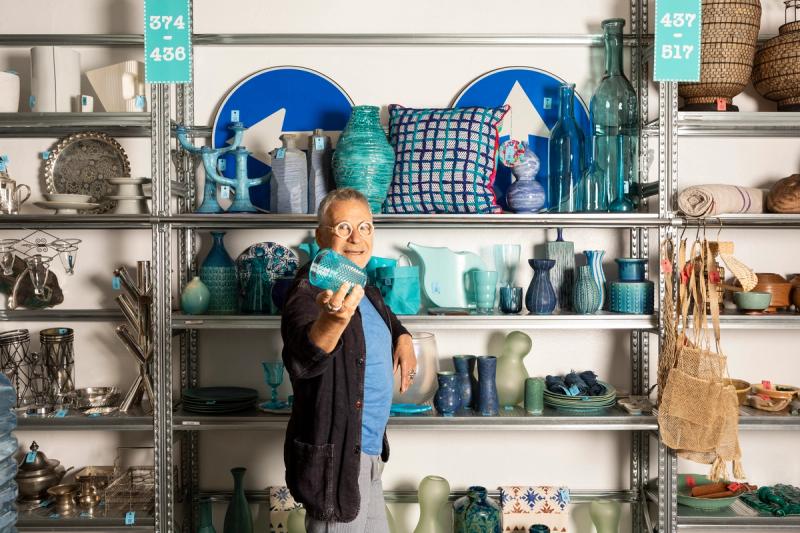
Daniel Rozensztroch on Curating “Take It or Leave It”
Daniel Rozensztroch has a rare knack for subtly telling stories through objects. The world of the Paris- and Nice-based stylist and former artistic director of the French boutique concept store Merci, widely known under Rozensztroch’s direction for its expertly edited selection of wares, brims with visual and material culture. From a young age, he began collecting items—perhaps most notably, spoons—and has published several books on his acquisitions over the years.
When, in New York in the 1980s, Rozensztroch met the Italian architect and designer Paola Navone—who has similarly been on an endless, self-described “treasure hunt” for intriguing items her whole life—there was an instant connection. “We fell in love,” Rozensztroch says. “That was the beginning of a very strong relationship.” Since then, the two have embarked on a number of projects together, both personal and professional, and traveled the world—everywhere from the Philippines to the United States to Morocco—to indulge in their shared passion of exploring flea markets and bazaars. Their professional collaborations range from developing an exhibition for the Parisian department store Printemps to conceptualizing the eccentric 25hours Hotel in Florence.
For their latest collaboration, the Milan Design Week exhibition “Take It or Leave It”—organized with The Slowdown and presenting an eclectic assortment of 1,000 numbered items collected or designed by Navone, which are being given away through a free, by-reservation, in-person lottery—Rozensztroch served as the curator. In the weeks leading up to the exhibition, he and Navone went through boxes upon boxes of things she had been keeping for years in storage. With his refined eye and instinctual approach, Rozensztroch then identified the most compelling pieces for inclusion. The result is a joyful display, with objects in a wide assortment of shapes and sizes, each a reflection of Navone’s adventurous attitude.
On the opening day of the exhibition this past Monday, Rozensztroch floated around the space, visibly overjoyed to see the lottery winners each with their respective spoils. Every so often, he would slip into the exhibition room, shifting objects by a centimeter here or an inch there, recalibrating certain items as others were removed. His glee was palpable.
During the cocktail party that evening, I stole Rozensztroch away for a few minutes to discuss the process and backstory behind the exhibition. It was the perfect setting: just us in the quiet exhibition space, looking out on the hundreds of objects he had so carefully arranged, sipping on grapefruit gin and tonics with a low hum of voices and clinking glasses leaking in through the doorway. During that brief, extraordinary interval, we spoke about everything from his decades-long relationship with Navone to his upcoming book chronicling his collection of sailor-themed ephemera.
Here, a condensed and edited version of our conversation.

How did you and Paola meet? Tell me about your relationship.
That’s a long, long, long story that started in the 1980s in New York. We have a friend that we love, Suzy Slesin, in New York, and I met Paola [through her]. She was working at that time for Knoll International. And I was in New York—I don’t remember for what reason, but I came from California to New York. And Paola asked me, “Do you know New York?” I said, “Of course, I know New York quite well,” and she said, “Okay, tomorrow, we have to do a tour together.” And we fell in love. That was the beginning of a very strong relationship. After that, we traveled a lot together. Sometimes we work together on beautiful projects, like when she worked in the Philippines, and we also did a huge exhibition in a department store in Paris, Printemps.
This is when you were at Merci?
No, Merci was many years after. I started with Merci in 2008. I was the artistic director there, and Paola and I did many collaborations together. We did an exhibition with Richard Ginori, and Paola did a fantastic exhibition for Merci. After that, we also did a collaboration with the ceramics company Fasano. We also worked on the 25hours Hotel in Firenze. Then she asked me to be the curator of this exhibition.
What did you think of the concept of “Take It or Leave It” when Paola first proposed it to you?
The last years of my collaboration with Merci, I was thinking of a new kind of relationship with consumers, and that was before the pandemic. For me, the thinking behind “Take It or Leave It” is very important, because it’s Paola’s story, but it’s not only Paola’s—it’s also a change of the mentality of the consumers. We are paying much more attention to: “I need it, I don’t need it.” “It’s important, it’s not important.” “I have it, or I don’t have it.” And all of these things completely change our attitude [about] buying things. That’s something that we really have to think about, and it’s the beginning of something that will grow in the future.
Tell me about the process of putting this exhibition together with Paola, and about your role in the project.
I cleaned … [Laughs] ... thousands of objects that Paola has collected for so many years. All these objects were in very bad condition, in storage somewhere in Milan. The first job was to open the boxes, to see what was inside, and to start to make a selection. Some were dirty, some were broken, some were without interest. We [arranged] them by colors, by style, and by themes. And little by little, something started to happen—the construction and the vision of these objects became very interesting, week by week. That was the beginning of the work. Of course, after that, we had to think about the concept and the idea of all these items that Paola decided to leave. The exhibition is “Take It or Leave it,” and Paola is the first to leave all these objects.
It is really a reflection of the fact that we [have been] addicted collectors, Paola and me, for so many years. Little by little, we have so many things at home, in storage, in closets, at Paola’s houses in Milan and around Italy—France for me—and all of these objects we loved. We bought them because they were interesting, they were nice, they were a source of inspiration in our work, but now it’s so many things that we cannot respirer (breathe). We had to decide to do something about that.
The decision came from Spencer [Bailey, The Slowdown’s editor-in-chief]. It’s interesting, because it’s something that has to do with a new kind of consumer, and the way that they’re buying things.

What was it like to go through her storage and archive? How did you go about selecting the items in the exhibition?
Oh, it was funny. First of all, it was a kind of discovering things. I was like a child in a big store, opening boxes and discovering extraordinary things. Many of these things I remembered, because I traveled a lot with Paola and I was with her when she bought them, and they reminded me of a market, a bazaar, or an antique store somewhere in the world. That was fantastic. I had forgotten about them, of course, because it has been so many years since we first discovered them. It was a very emotional process.
I love to do this kind of selection, too. It’s a kind of synthesis. When you put one object, okay, you don’t know exactly if you like it. But when we mixed it with something [that created a] shock of culture, or with something similar, it became more and more interesting. That’s the story of a collection. When you have ten pieces, or one hundred pieces, it becomes very strong, very interesting.
We arranged them by the colors, the textures, by use, all of these things. It’s a construction. You make a story. It’s like when you are a writer, words, together, make a sentence.
How did you go about organizing the objects in this particular way?
It was a big job, I have to say, but easy. Because, as I told you, the objects speak together—one object speaks with another object. When you put them together, you make a story. It’s white; it’s blue. It’s ceramics; it’s glass. Sometimes people ask me how I work, and it’s very difficult for me to explain that, because it’s something that I did very fast. I had an [instinct] of how to put the things together.
You previously organized a Milan Design Week exhibition with Merci in this same space. How does this project compare to that one?
For the display, it was the same thing. But the objects were very different. The difference here is that I love this eclectic selection of objects; they are all different. They came from all over the world. They came from different carriers. They came from different savoir faires. Merci was much more of a store, and this is more like a bazaar. And I love bazaars. When I’m traveling, the first place where I want to go is the market, the bazaar, the flea market, all of these places, because it’s there that you can find one object in the middle of nothing. That’s something that gives me such a strong pleasure, a kind of adrenaline.
Like a diamond in the rough.
Exactly. Fantastique!
You mentioned you’ve traveled the world with Paola. Can you tell a story about an object that you found here that you discovered while traveling with her?
I remember, in the Philippines, we had this extraordinary opportunity to buy everything we wanted, especially antiques. We had cash, we paid, and we put the things in storage, and at the end, we sent it to Paris. It was so fun to do that together. To travel and to discover those things, when you are alone, it’s okay. But when you are with somebody with the same taste and same kind of immersion, that’s fantastic.
What, to you, is so defining about Paola and her work?
Paola is really unique, and that’s something that I knew from the beginning. She feels completely free to do everything she wants. She knows exactly what she hates, and she has no limit. Everything she does is so funny, with emotion, with culture—with culture, that’s something very important, all of these sources of inspiration that come from around the world. She’s unique in that way, especially in Italy. Italian design was so formal for so many years. She stopped walking in that direction a long time ago.
What’s next? Are you working on anything exciting right now?
I’m doing a book on a big collection of sailor-themed objects that I’ve collected for many, many years. It’s a collection that, until now, I refused to show, because I did a lot of books on my everyday objects that everybody knows now, but this collection is much more intimate. I was not really ready to show that, but my editor in New York convinced me to do it. Now I’m very happy, because the book will be very beautiful. This book is on collecting objects on sailors, but starts with children’s toys and finishes with very erotic pictures. It’s a kind of panorama.